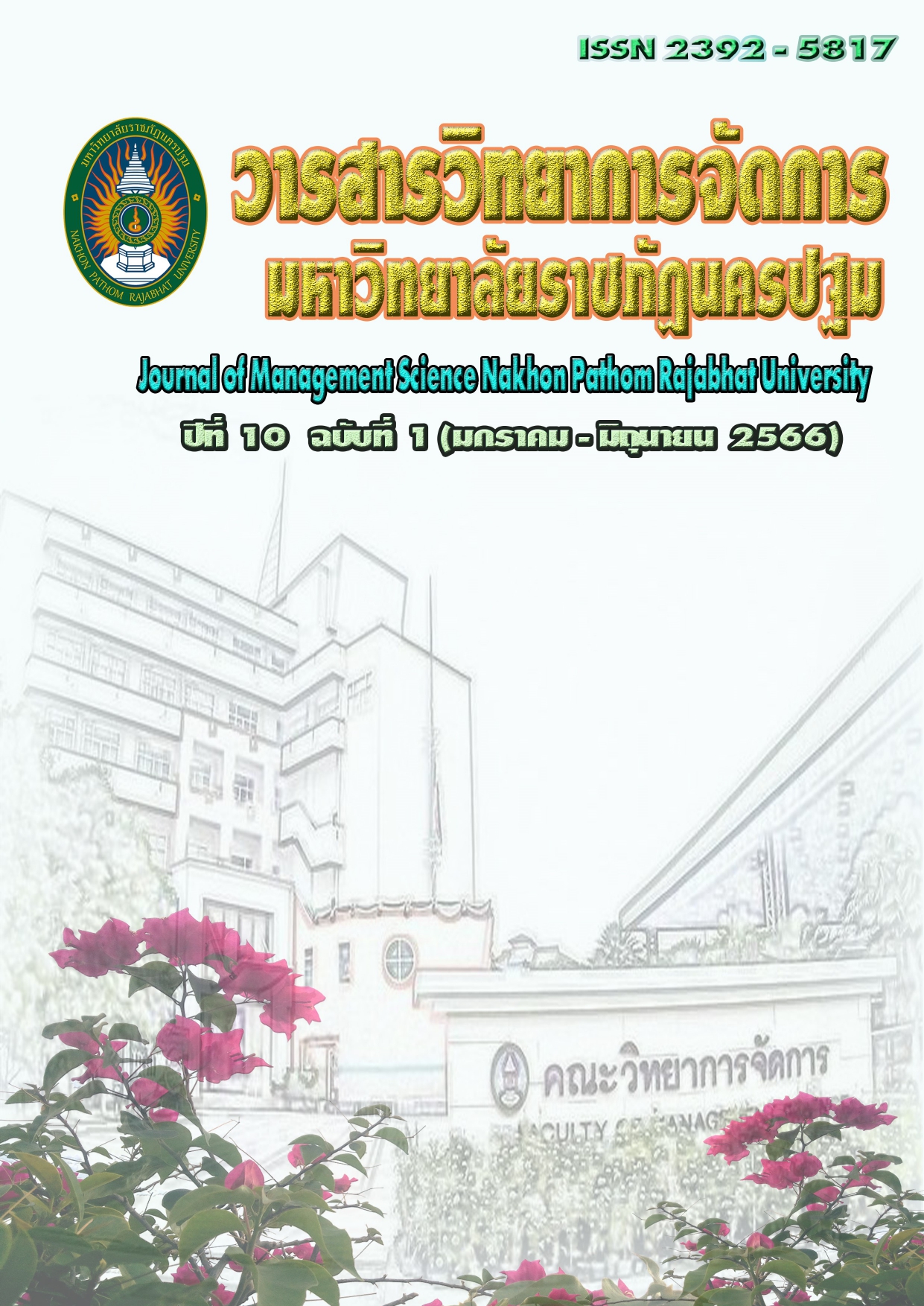The Guideline of the Local Wisdom Herbal Tea Product Development for Promote Creative Economy in Kanchanaburi Province
Main Article Content
Abstract
This research aims to study sought to investigate the basic information, operation, problem conditions, product development needs, and guidelines for the development of herbal tea products from local wisdom to promote the creative economy inKanchanaburi. The data collection for this research will involve two groups of participants. The main data providers were community enterprises that produce herbal tea products based on local wisdom in Kanchanaburi province. The sampling method for this group will be a convenience sampling technique, with a minimum of five groups of 10 individuals. Another one is the sample groups consisting of individuals who have previously purchased herbal tea products in Kanchanaburi province. The sampling method for this group will be a convenience sampling technique, with a sample size of 400 people.
The qualitative research findings from the interviews with community enterprises that produce herbal tea products based on local wisdom in Kanchanaburi province, turmeric, ginger, lemongrass, pandan leaves, citronella, and butterfly pea are the main herbs grown. Their business is wholesale and middleman. Storage of fungal diseases and water constraints cause production fluctuations in the communities. Moreover, community groups want to pass down local knowledge. Thus, they have attempted to create a learning center for herbal medicine students. They also strive to match commercial shop product quality.
The quantitative research results from individuals who have previously purchased herbal tea products in Kanchanaburi province aimed to identify strategies for product development. It was found that the variations in demographic factors significantly influenced purchase decisions for different product options. Additionally, factors related to purchasing behavior, such as the reasons for selecting a particular product, the location of the point of sale, and the motivations behind purchasing from specific sources, also influenced diverse purchasing decisions. The change in purchasing decisions was 45.20%, with the remaining 54.80% impacted by other variables. When each side is considered, products have the most influence on the purchase decision (Beta = 0.31), followed by price (Beta = 0.26), place (Beta = 0.18), and promotion (Beta = 0.10). Therefore, the development of herbal tea products should focus on packaging that preserves product quality. The products should be diverse to cater to the needs of various consumer groups, and clear product information should be provided to instill confidence in consumers.
Article history: Received 24 March 2023
Revised 11 June 2023
Accepted 12 June 2023
SIMILARITY INDEX = 3.83 %
Article Details

This work is licensed under a Creative Commons Attribution-NonCommercial-NoDerivatives 4.0 International License.
The views and opinions of the article appearing in this journal are those of the author. It is not considered a view and responsibility of the editorial staff.
References
กนกวรรณ เพ็ชรพลอย. (2560). ปัจจัยที่มีผลต่อการตัดสินใจซื้อผลิตภัณฑ์สมุนไพรไทยของนักท่องเที่ยวชาวรัสเซีย: กรณีศึกษา สยามสปา สาขาจตุจักร. ศิลปศาสตรบัณฑิต สาขาวิชารัสเซียศึกษา คณะศิลปะศาสตร์ มหาวิทยาลัยธรรมศาสตร์.
ชงโค ดรลาดพันธุ์, และ วิษณุ สุมิตสวรรค์. (2563). การตัดสินใจซื้อสินค้าอุปโภคผ่านสื่อเครือข่ายออนไลน์ ของผู้บริโภคในเขตเทศบาลนครขอนแก่น จังหวัดขอนแก่น. วารสารสังคมศาสตร์และมานุษยวิทยาเชิงพุทธ, 5(6), 118-131.
นคเรศ ชัยแก้ว อุดมศักดิ์ สาริบุตร สถาพร ดีบุญมี ณ ชุมแพ และ ผดุงชัย ภู่พัฒน์. (2556). การศึกษาและพัฒนาบรรจุภัรฑ์ลำไยอบแห้ง จังหวัดลำพูน. วารสารวิชาการ ศิลปะสถาปัตยกรรมศาสตร์ มหาวิทยาลัยนเรศวร, 3(2), 86-95.
นัสทยา ชุ่มบุญชู. (2560). พฤติกรรมผู้บริโภคผลิตภัณฑ์อาหารและสมุนไพร: กรณีศึกษาพื้นที่จังหวัดกาญจนบุรี. วารสารวิทยาลัยโลจิสติกส์และซัพพลายเชน, 3(2), 76-86.
ประทินร์ ขันทอง, และ ธนากร ธนาธารชูโชติ. (2562). รูปแบบการตลาดธุรกิจสินค้าออนไลน์ในประเทศไทย. วารสาร มจร พุทธปัญญาปริทรรศน์, 4(2), 45-56.
รัญชิดา ดาวเรือง, และ วัชรพจน์ ทรัพย์สงวนบุญ. (2561). การศึกษาปัจจัยที่มีอิทธิพลต่อการตัดสินใจซื้อชา
ในจังหวัดกาญจนบุรี. วารสารสังคมศาสตร์ มหาวิทยาลัยศรีนครินทรวิโรฒ, 21, 206-217.
วิสาหกิจชุมชน. (2565). ระบบสารสนเทศวิสาหกิจชุมชน กองส่งเสริมวิสาหกิจชุมชน กรมส่งเสริมการเกษตร. [ออนไลน์] ค้นเมื่อ 9 กุมภาพันธ์ 2562 จาก
https://smce.doae.go.th/ProductCategory/รายชื่อวิสาหกิจชุมชนและเครือข่ายวิสาหกิจชุมชน
ศิริวรรณ เสรีรัตน์ ศุภร เสรีย์รัตน์ องอาจ ปทะวานิช และ ปริญ ลักษิตานนท์. (2546). การบริหารการตลาดยุคใหม่. กรุงเทพฯ: บริษัท ธีระฟิล์ม และไซแท๊กซ์ จำกัด.
สมภพ ประธานธุรารักษ์ พร้อมจิต ศรลัมพ์ นพมาศ สุนทรเจริญนนท์ และ ธีรเดช อุทัยวิทยารัตน์. (2548). ศึกษาทบทวนการพัฒนามาตรการด้านวิจัยและการจัดการความรู้เพื่ออนุรักษ์ พัฒนาและคุ้มครอบภูมิปัญญาไทย สุขภาพวิถีไทย. กรุงเทพฯ: สถาบันวิจัยระบบสาธารณสุข.
สำนักส่งเสริมการค้าสินค้าเกษตรและอุตสาหกรรม กรมส่งเสริมการค้าระหว่างประเทศ กลุ่มงานครัวไทยสู่โลก. (2564). แนวโน้มอาหารและเครื่องดื่มในตลาดโลกปี 2021. กรุงเทพฯ: กรมส่งเสริมการค้าระหว่างประเทศ.
สุดาดวง เรืองรุจิระ และ ปราณี พรรณวิเชียร. (2529). หลักการตลาด. (พิมพ์ครั้งที่ 3) กรุงเทพฯ: ประกายพรึก.
Briston, J.H. and Neill, T.J. (1972). Packaging Management. Epping, Essex: Gover press.
Cochran, W. G. (1997). Sampling Techniques. (3rd ed). New York: John Wiley and Sons.
Cronbach, L. J. (1970). Essentialsofpsychologicaltesting. (3rd ed). New York: Harper & Row.
Kotler. (1994). Reconceptualizing marketing: An interview with Philip Kotler. European Management Journal, 12(4), 353-361.
WHO, W. H. (2018). Traditional and complementary medicine in primary health care. Switzerland: WHO Headquarters in Geneva. Retrieved from Traditional, complementary, and integrative medicine.


